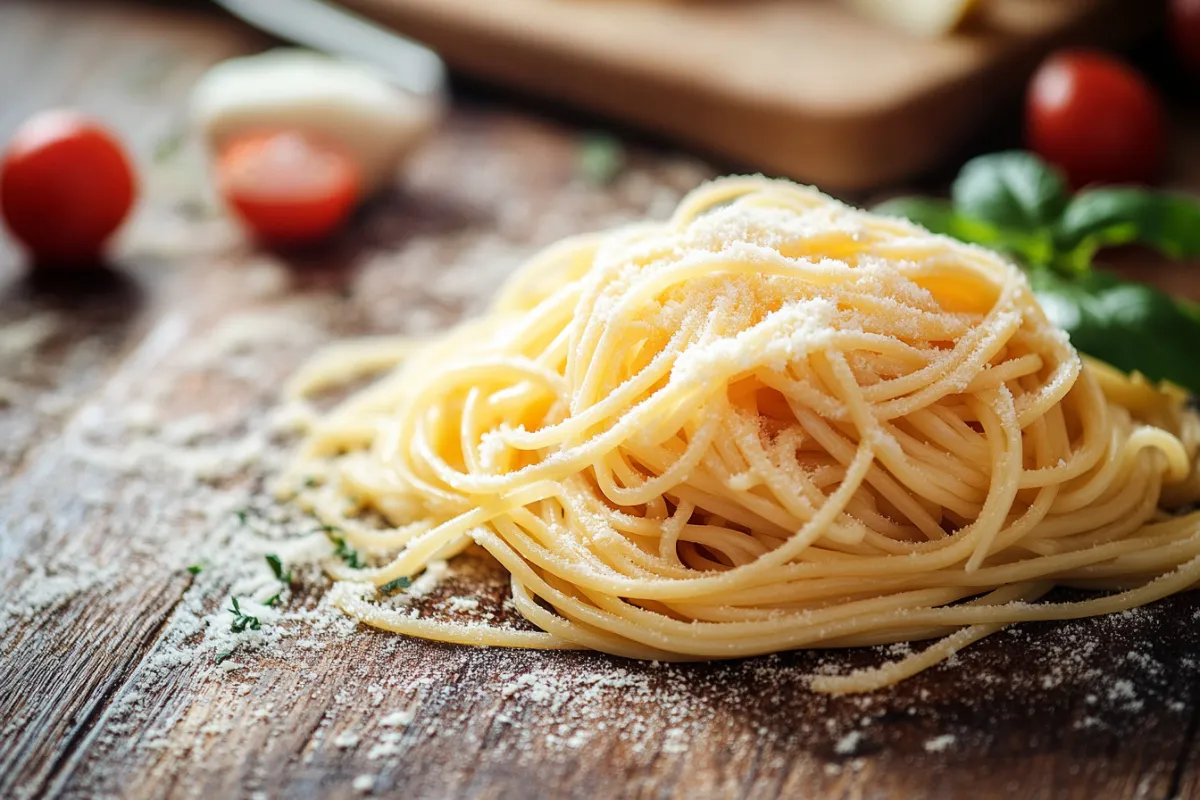Capellini vs Spaghettini: What’s the Difference and When to Use Each?
Italian cuisine is revered worldwide for its variety and richness, particularly when it comes to pasta. Among the most popular thin pasta varieties are capellini and spaghettini. Although these two pasta types share similarities in appearance, they differ in texture, thickness, and culinary applications. These distinctions, though subtle, play a significant role in determining the best pasta for your dish. So, what are the main differences in the Capellini vs Spaghettini debate, and how do you choose the right one?
Understanding the differences between capellini and spaghettini can enhance your cooking, whether you’re making a simple weeknight dinner or preparing an elaborate Italian meal. This guide will explore the origins, characteristics, and culinary uses of both capellini and spaghettini, helping you make the right choice in your kitchen.
What Is Capellini?
1. Defining Capellini: Origins and Meaning
Capellini, also commonly referred to as angel hair pasta, is one of the thinnest pasta varieties available. The name capellini comes from the Italian word capelli, which means “hair,” and the diminutive suffix -ini, which translates to “little.” Therefore, capellini directly translates to “little hairs,” aptly describing the fine, hair-like strands of this pasta.
2. Physical Characteristics of Capellini
With a diameter ranging from 0.85 mm to 0.92 mm, capellini is delicate and thin. It is significantly thinner than most pasta varieties, including spaghettini. Because of its delicate nature, capellini requires careful handling during preparation. It cooks very quickly—typically within 2 to 3 minutes—which makes it an excellent option for fast meals.
Capellini is also favored in light dishes that won’t overpower its fine texture. It’s particularly well-suited to olive oil-based sauces, simple tomato sauces, or light broths. Moreover, capellini pairs perfectly with seafood and vegetable-based dishes, allowing the pasta to complement the flavors without dominating the dish.
3. Capellini’s Role in Italian and Global Cuisine
Capellini is commonly used in southern Italian cuisine, where light dishes featuring seafood and fresh vegetables are more prevalent. Its ability to absorb delicate flavors quickly without becoming too heavy makes it a favorite for summer dishes and light dinners. Outside of Italy, capellini has gained popularity in international kitchens. For example, in some Asian fusion dishes, capellini is used as a substitute for rice noodles due to its thinness and quick cooking time.
If you’re looking for more information about how capellini fits into Italian and global cuisines, check out our comprehensive Ultimate Guide to Capellini Pasta.
What Is Spaghettini?
1. Spaghettini: Origins and Meaning
Spaghettini is a close relative of the more commonly known spaghetti. However, it is thinner than regular spaghetti but thicker than capellini. The name spaghettini comes from the Italian word spaghetti, meaning “little strings.” The suffix -ini indicates that it is a smaller, thinner version of spaghetti.
2. Physical Characteristics of Spaghettini
Spaghettini typically measures between 1.5 mm and 1.8 mm in diameter, making it thicker than capellini but still considered a thin pasta. This added thickness gives spaghettini more structure, which allows it to hold up better with heartier sauces compared to capellini. As a result, spaghettini is more versatile in the kitchen, as it can be used in a wider variety of dishes.
Due to its slightly thicker nature, spaghettini takes longer to cook than capellini, typically requiring about 5 to 7 minutes to reach the perfect al dente texture. Its texture makes it a great option for dishes that call for a more substantial pasta without being as heavy as full-sized spaghetti.
3. Spaghettini in Italian and Global Cuisine
Traditionally, spaghettini is popular in central and northern Italy, where pasta dishes tend to feature richer sauces like bolognese, carbonara, and cream-based sauces. The firm texture of spaghettini allows it to hold its shape and absorb the flavors of these sauces, making it a staple for more substantial meals.
Additionally, spaghettini is widely used in Mediterranean and Middle Eastern cuisines. It often appears in cold pasta salads, paired with bold flavors like olives, feta, and sun-dried tomatoes. Because of its versatility, spaghettini has become a favorite in many kitchens around the world.
For more insights into spaghettini and its culinary applications, take a look at our Capellini vs Vermicelli: Differences and Uses, which delves into how different types of thin pasta are used in various dishes.
Capellini vs Spaghettini: Key Differences
1. Thickness and Texture
When comparing Capellini vs Spaghettini, the most notable difference is their thickness. Capellini is significantly thinner, with a diameter of 0.85 mm to 0.92 mm, making it one of the thinnest pasta types available. On the other hand, spaghettini is slightly thicker, measuring between 1.5 mm and 1.8 mm. This additional thickness gives spaghettini more bite and structure when cooked, allowing it to hold up to richer, heartier sauces.
The texture of capellini is soft and delicate, which makes it perfect for light, oil-based sauces and quick-cooking meals. In contrast, spaghettini offers a firmer bite, making it a better choice for dishes that require more substantial pasta.
2. Cooking Time
Another critical factor in the Capellini vs Spaghettini debate is cooking time. Capellini cooks extremely quickly, usually within 2 to 3 minutes. This makes it an excellent option for dishes that require fast preparation, but it also means you need to monitor it closely to avoid overcooking.
On the other hand, spaghettini requires a longer cooking time, typically taking between 5 and 7 minutes to reach al dente. While this makes spaghettini slightly less convenient for quick meals, its firmer texture allows it to withstand richer, thicker sauces without becoming mushy.
3. Sauce Pairings and Culinary Applications
The differences in thickness and texture between capellini and spaghettini significantly affect how they pair with sauces. Because capellini is so delicate, it pairs best with light, simple sauces that won’t overpower the pasta. Olive oil, garlic, and fresh tomatoes are common ingredients in capellini dishes. Seafood, such as shrimp or clams, also pairs well with capellini due to the pasta’s ability to absorb delicate flavors.
In contrast, spaghettini can handle a wider range of sauces, from light olive oil-based sauces to heavier meat or cream sauces like bolognese or alfredo. The added thickness and structure of spaghettini allow it to absorb and complement more robust flavors, making it a more versatile pasta.
Why Pasta Size Matters in Italian Cooking
In Italian cooking, the size and shape of the pasta are key factors in determining how well it pairs with a specific sauce. Thicker pastas are typically used with hearty sauces that cling to the pasta, while thinner pastas are best suited for light, delicate sauces. The comparison between Capellini vs Spaghettini exemplifies this concept, as each type of pasta serves a different purpose in Italian cuisine.
For example, if you were to pair capellini with a thick, meat-based sauce, the pasta would likely become overwhelmed by the richness of the sauce. Conversely, a light olive oil sauce would be lost in the heartiness of spaghettini. By choosing the right pasta for your dish, you can create a balanced, flavorful meal.
If you’re interested in how pasta size and shape influence sauce pairing, check out our detailed guide on Capellini vs Vermicelli: Differences and Uses.
Cooking Techniques for Capellini and Spaghettini
Cooking pasta correctly is essential for achieving the right texture and flavor. Both capellini and spaghettini require slightly different cooking techniques due to their varying thicknesses and textures.
1. Cooking Capellini
Due to its delicate nature, capellini requires careful attention during cooking. It typically takes only 2 to 3 minutes to cook, so it is important to monitor it closely to avoid overcooking.
Tips for cooking capellini:
- Use plenty of water to allow the pasta to move freely and cook evenly.
- Salt the water generously to season the pasta.
- Stir frequently to prevent the fine strands from sticking together.
- Drain the pasta immediately after cooking and toss with sauce to prevent it from clumping.
2. Cooking Spaghettini
Because spaghettini is slightly thicker, it can handle a longer cooking time and is more forgiving than capellini. Typically, spaghettini takes about 5 to 7 minutes to reach al dente.
Tips for cooking spaghettini:
- Use a large pot of water to give the pasta plenty of room to cook.
- Stir occasionally to prevent sticking.
- Cook spaghettini to an al dente texture for the best results, then toss it with your chosen sauce.
Capellini vs Spaghettini: Nutritional Comparison
Both capellini and spaghettini provide similar nutritional benefits, as they are made from similar ingredients. However, slight differences in thickness and serving size can affect their nutritional content.
Capellini Nutritional Information (Per 2 oz serving):
- Calories: 200
- Carbohydrates: 40 grams
- Protein: 7 grams
- Fiber: 2 grams (whole wheat)
Spaghettini Nutritional Information (Per 2 oz serving):
- Calories: 220
- Carbohydrates: 42 grams
- Protein: 8 grams
- Fiber: 2 grams (whole wheat)
For those who want to increase their fiber intake or lower their glycemic index, whole wheat or gluten-free versions of both pasta types are available. While the differences in nutritional content between capellini and spaghettini are small, choosing whole wheat varieties can provide additional health benefits.
Frequently Asked Questions (FAQ)
1. What is the difference between Capellini vs Spaghettini?
Capellini is much thinner, typically measuring between 0.85 mm and 0.92 mm in diameter, while spaghettini is slightly thicker, measuring between 1.5 mm and 1.8 mm. This difference in thickness affects both the texture and the cooking time.
2. Can I substitute Capellini for Spaghettini?
Yes, but keep in mind that the texture and cooking time will be different. Capellini cooks faster and is more delicate, making it better suited for light sauces. Spaghettini, being thicker, holds up better to heartier sauces.
3. What dishes are best for Capellini vs Spaghettini?
Capellini is ideal for light dishes with olive oil or seafood-based sauces, while spaghettini works well with more substantial sauces like bolognese, pesto, or cream-based sauces.
4. Which pasta is healthier: Capellini or Spaghettini?
Nutritionally, both pastas are similar. However, whole wheat versions of either pasta will provide more fiber and nutrients than regular versions.
Conclusion
In the debate between Capellini vs Spaghettini, it’s clear that each pasta type has its strengths depending on the dish you’re preparing. Capellini is best for light, quick meals with delicate sauces, while spaghettini offers more versatility and structure, making it suitable for a wider variety of dishes, including those with rich, hearty sauces.
Understanding when to use capellini versus spaghettini will help you elevate your cooking and ensure that every dish has the perfect balance of texture and flavor. For more pasta insights, don’t forget to visit our Ultimate Guide to Capellini Pasta.

